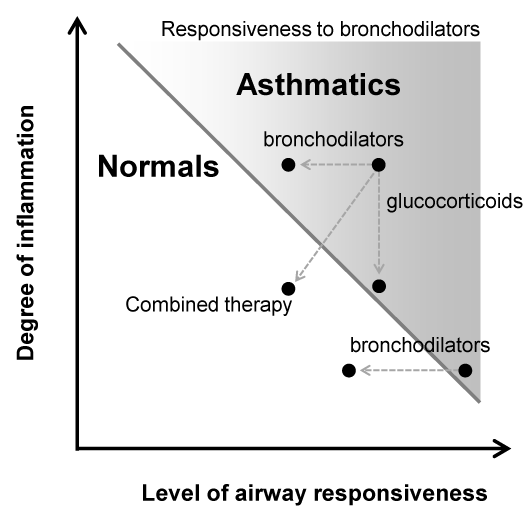
 |
| Figure 6: Inflammation and airway hyperresponsiveness combine to cause asthma. The diagonal grey line represents the threshold to diagnose asthma. The cutoff obviously varies from one clinician to the other. The cutoff can also vary in time due to the effect of inflammation on airway responsiveness (see variable component of airway responsiveness in the text). During the natural course of asthma, a part of symptoms, which varies in magnitude in between patients, are mediated by the level of airway responsiveness. In turn, the level of airway responsiveness depends on both the amount of inflammationderived spasmogens present, which dictates the level of airway smooth muscle activation and the patient’s level of airway responsiveness per se (i.e. responsiveness to any given amount of spasmogens). Whereas someone hyperresponsive will experience symptoms with very little inflammationderived spasmogens, a normo- or hyporesponsive individual will tolerate more inflammation and spasmogens before experiencing symptoms and be diagnosed. The filled circles and the dashed arrows indicate how anyone’s asthmatic can be shifted within this frame by the mainstay therapies for asthma. These therapies relieve symptoms by either decreasing the level of airway smooth muscle activation (bronchodilators) or by buffering the inflammation (glucocorticoids). The responsiveness to bronchodilators (grey shaded gradient in asthmatics) depends on the contribution of airway smooth muscle contraction in the elaboration of symptoms. Whereas hyporesponsive patients who suffer asthma predominantly due to severe inflammation are refractory to bronchodilators, patients hyperresponsive with very little inflammation can be fully controlled by bronchodilators alone. It is also important to understand that asthma is not a dichotomic variable. Anyone in the population fits somewhere in this frame. The cutoff for diagnosis is only made to guide clinical practice. |